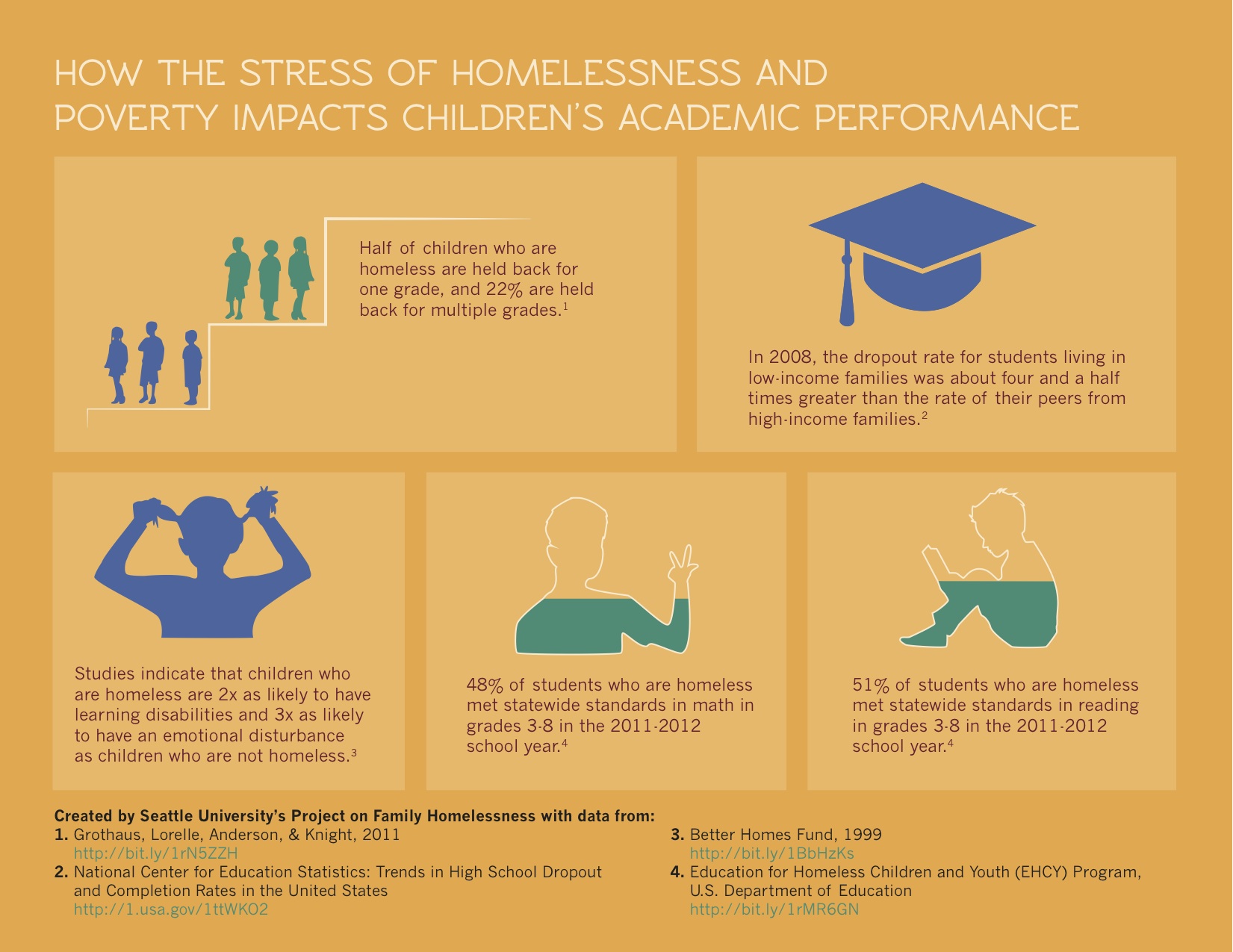Homelessness is commonly misunderstood as being a problem that only affects adult men and women. In actuality, the range of groups experiencing homelessness is very broad and includes youth and young families. Homelessness, and factors linked to homelessness, strongly impact the ability of children to be successful in their studies. The below infographic, created by Seattle University’s Project on Family Homelessness, illustrates how homelessness and poverty can directly impact a child’s ability to gain a good education.
The graphic shows that in the United States in 2008, the dropout rate for students living in homelessness was 4x greater than that of students from high-income families. While it may be assumed that the quality of education between both groups might be dependent on family income, this doesn’t explain why homeless students were more likely to drop out of school. The reality is that students living in critical housing situations have pressures and stressors that their housed peers may not experience. Some youth may struggle to have continuous access to education or have difficulty with attendance as a result of their housing situation. Others may be unable to stay in school due to financial constraints because they need to obtain some sort of income to meet their day to day needs. It’s difficult to look ahead and invest in one’s education when you don’t feel like you have the time, or supports in place, to get you through today.
The graphic also states that children who are homeless are far more likely to have learning disabilities or an emotional disturbance compared to children who do not live in homelessness. One potential source for this discrepancy is poor nutrition. Proper access to nutritional food plays an important in role in all of our lives. The importance of access is emphasized when we’re talking about young children as they are in a vital stage of their physical and mental development. A lack of access to nutrition can result in stunted growth. Poor nutrition, which the vast majority of homeless youth suffer from, significantly increases the likelihood of infection and is also a cause of impaired functioning. Access to nutritious food is just one example of several factors that are strongly linked to, and often result from, poor housing conditions. Other factors that may contribute to learning disabilities and emotional disturbances include prenatal substance abuse, being a victim of domestic abuse, and witnessing violence as a child.
Several researchers and organizations have created lesson plans and toolkits targeting different stakeholders in hopes of addressing the educational needs of homeless youth. There are many different ways to approach the issue. This includes using resources that focus on preparing teachers to work with homeless children. Alternatively, there could be programs that focus directly on children outside of the classroom setting, perhaps offering extra out of class support. Interventions that may not seem directly linked to education at first glance should also be considered. For example, past research has shown providing free and nutritious meals to children in poverty has helped break down barriers associated with poverty and education.
As I mentioned earlier, homeless children are often more likely to slip under the radar compared to groups that we easily identify as being homeless. It can be difficult to identify who is homeless; the term “hidden homeless” is used to refer to this subset of the homeless population. People often go to great lengths to hide their status as homeless individuals. In fact, up to 80% of homeless Canadians who are homeless may not be living on the street. This may be why the general population seems to be unaware of the unique barriers and difficulties faced by these groups. It’s completely understandable why people may want to avoid being labelled as homeless, as individuals living in homelessness are still framed as being dangerous, often referred to as threats to public safety. Once again, we find that the everyday stigma associated with being homeless can be a powerful barrier − and detriment − to the well-being of homeless populations, including homeless children.


